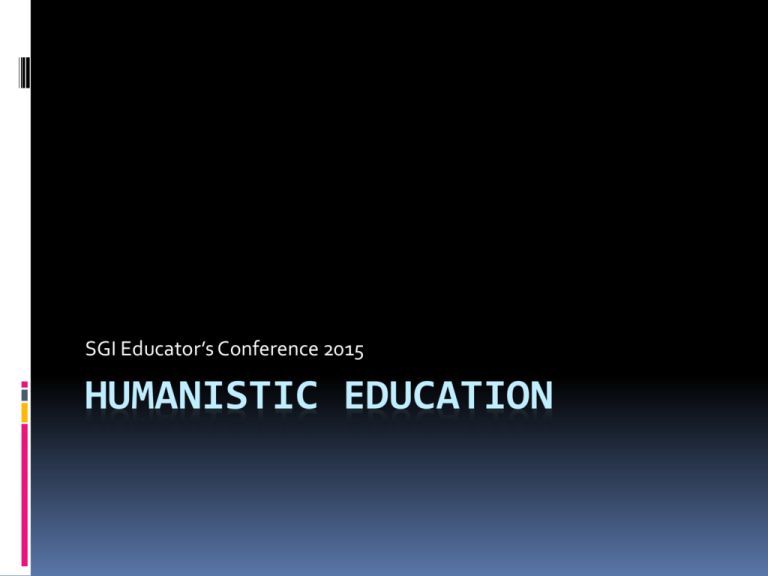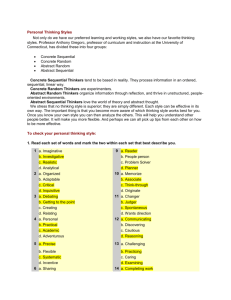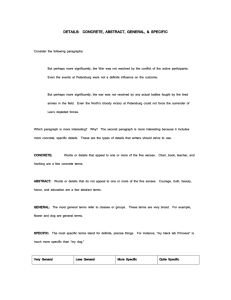SGI Educators conference presentation
advertisement

SGI Educator’s Conference 2015 HUMANISTIC EDUCATION Soka Values Makiguichi: To make students happy Ikeda: To foster humane and life-affirming values, on peace and on encouraging students to lead contributive lives. Historic Values In North America Education started by religious groups and taken over by state Emphasis on abstract thinking and rote learning i.e. Learn and regurgitate Gentlemen’s education was non practical Latin, classics, travel, languages Practical skills considered evidence of lower class status. Higher Ed still divided Abstract, theoretical: University > Desirable Practical: College > Necessary Efforts recently to combine - polytechnical school Highest Value Today Critical Thinking Life skill for all situations? Recent study: Students need to utilize concrete applications st 1 before attempting critical thinking. Critical thinking skills in one area do not transfer to another knowledge area E.g. Politics, nursing, law, medicine, advertizing etc. Compassion for Students Critical thinking is great but can be force fed at expense of student’s growth like other ideologies. Stage 1 – Students manipulate concrete objects or processes & learn the lingo Step 2 – Students discuss what worked and values involved Step 3 – Student draws own conclusions based on experiences. Vocabulary from Experience Professor Hirsch, states that students learn abstract knowledge comes from exploration of “real subject matter” Concrete exploration leads to conceptual realizations. We cannot put the cart before the horse. Teachers Like Abstracts Teachers background - information class Find thinking troubles of concrete thinkers perplexing We were read to. Reading builds abstract skills of: Imagination Making inferences We want to Speculation as to outcome invite them into Projection as to motivation our pool but Seeing the whole picture they are scared. Concrete thinkers did not get this Concrete Thinkers ” ...experience the world as a series of separate, discrete objects and events, and Learn by the experience of working with objects, or by seeing or hearing concrete examples. Once they learn how something is done, that’s the only “right” way to do it. Ruth Miller 2011. We help them see patterns in the dots. Cultural Background 83% International Students 8% in 2014 are in Ontario. About 16% of all Int. students are in Ontario This does not count ESL citizens and/or first generation Canadian residents Statistics Canada Education in many cultures differs from Canada E.g. Indian Education focuses on rote learning. http://www.newindianexpress.com/cities/chennai/Rote-Learning-Biggest-Hurdleto-Education-Prof/2014/08/04/article2363619.ece African education is based on respecting the word of others versus questioning it. Critical Thinking – Considered disrespectful? www.emeka.at/african_cultural_vaules.pdf China – rote learning issues in education http://business.time.com/2013/06/27/china-just-as-desperate-for-education-reform-as-theu-s/ Critical Thinking Fallacies Critical thinking is not an independent skill, usable across disciplines. “..no evidence that practice of this sort enhances abstract thinking in a generalizable way. ... This failure of transfer is connected with the theme of “domain specificity” ..: a person can be a reasonably flexible and abstract thinker in one area (e.g., sports) and remain a concrete thinker in another area (e.g., literature). Therefore, attempts to facilitate increasingly abstract thinking should be made within all relevant academic areas ( e.g., math, literature, science, social studies), without expecting that improvements in one area will yield improvements in another area.” From Tutorial: Concrete vs. Abstract Thinking by Mark Ylvisaker, PHd Professor of Communication Sciences and Disorders at the College of Saint Rose in Albany, New York, Learn.net Start Concretely Hirsch says the build up of knowledge should be “sensible, cumulative” to build student confidence. Vocabulary Declines, With Unspeakable Results E.D. Hirsch Jr. Challenges for Concrete Thinkers Multi-step sequential thinking Predicting logical outcomes Creative imagination – requires synthesizing Problem solving – many unknown steps Instructions for students to “fill in the blanks” Research, analysis of articles & information Fear of being wrong Professor Anthony Gregorc, professor of curriculum and instruction at the University of Connecticut Strengths of Concrete Thinkers Programmed instruction, workbooks, lab manuals, field trips, and applications (Gregoric, 2014) Hands on projects Repetition Direct, practical knowledge Activity based learning Order and quiet Step by step directions and Guided Practice Finding accepted method Approval for specific work done Need Predictability in: The Course Design The Major Assignment The Rubric The In-Class Assignments Predictability in Course Design One pivotal character to identify with ..\..\1. Introduction to Journey of Ernie.pptx Grasp impact of events on a feeling level. Care about character Supports acquisitions of abstract concepts. Back to index Predictability of Assignment Terms and commands explicitly defined and made numeric E.g. Compare 6 positive & three negative qualities in each site/article/proposal with the same in another site/article/proposal. Return to Index Mandatory Structure Require mandatory section heads Under those titles give questions that require answers. Return to Index Operationalize Abstract terms: Examples Analyze: Find connections Compare and contrast? – Define these. Define : Tell the meaning and the qualities of.. Describe: Observe and select important details Evaluate: Use facts to argue whether something is good, bad, best etc. Propose: Identify a problem and argue for a solution Return to Index Rubric Potholes 1 Rubric - construction manual for assignment. Define qualitative evaluation in quantitative terms when possible. E.g. Did a good job of evaluating. Try : Identified and compared three positive factors and three negative factors in each article. Instructive for concrete student and reduces appeals based on differing interpretations Clarity not “What I meant was...” Give Them Imagination The Scenario Generator. Give Handout In Class Assignments Give them a standard sequence of behaviours they must follow, track and evaluate. With a standard format, other group members can give valuable feedback even if the instructor cannot be there. Procedural Feedback Sheet End References 1 Cai Cai X Subway-Poem-Checklist-and-Rubric, http://w/ ww.docstoc.com/docs/100711096 Ennis, RH, 1993, Critical thinking assessment‟, Theory into Practice, vol.32, no. 3 , pp. 179 - 186. Ennis, RH,1989, “Critical thinking and subject specificity: clarification and needed re search‟, Educational Researcher, vol.18, no. 3, pp. 4 - 20. Graves, Roger, Clear instructions, great expectations retrieved from http://www.ualberta.ca/~graves1/assignments.pdf on June 1, 2014 Gregorc A, from Thomas G. Reio Jr. and Albert K. Wiswell (2006). "An Examination of the Factor Structure and Construct Validity of the Gregorc Style Delineator". Educational and Psychological Measurement 66 (3): 489. Retrieved from http://www.newindianexpress.com, cities/chennai, RoteLearning-Biggest-Hurdle-to-Education-Prof/2014/08/04/article2363619.ece, References 2 Nicholson T, & Dymock, S, (2010) Teaching Reading Vocabulary NZCER Press, Aukland, NZ Romano, A, “Best Practice Based Model of Context - Specific Critical Thinking in Management”, World Journal of Social Sciences Vol. 2. No.1. January 2012. Pp.1 - 11 A Sugrue B, PhD, CPT, http://www.performancexpress.org/ 0212/mainframe0212.html#title3 Ylvisaker Mark Hibbard, Mary. and Feeney, Timothy, . What Are Concrete and Abstract Thinking? Retrieved from Learn.net on May 15, 2014 at http://www.projectlearnet.org/tutorials/concrete_vs_abstract_thinki ng.html Wang, J Basic Idea, Retrieved May 2014







